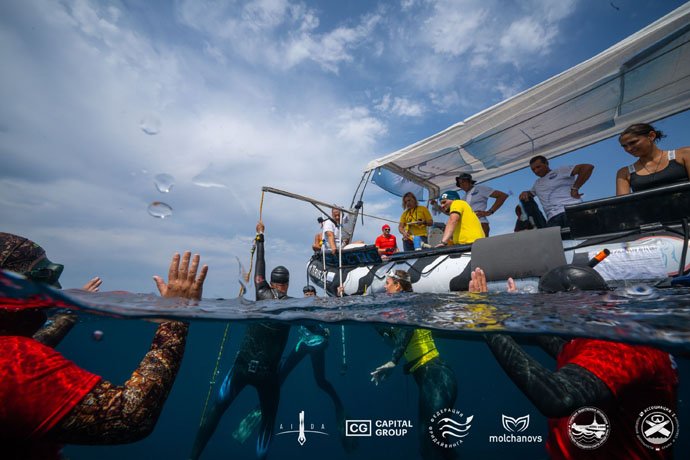CO2 workout for advanced freediving athlets
Everyone knows that freediving training is divided into O2 and CO2. An approximate rationale for this is that the freediver faces two main diving problems - hypoxia and hypercapnia. Therefore, it was proposed to train these states separately. O2 training means long delays and long rest so that during a dive, oxygen in the blood drops sufficiently, and during rest, CO2 is removed from the body. CO2 training consists of relatively short delays and short rests. Here the task is to ensure that the CO2 does not have enough time to leave the body during the rest and the freediver constantly works with its high content. This is such a short theory that even novice freedivers know. Today I will speculate on this topic, again only based on my own experience. I am not trying to prove that my position is the only correct one, but I am sharing a new look that gives you more room for introspection.

Written by: Vlad MasterskikhAIDA instructor, EU pool champion
So, if you read my article on the methodology of training dynamic disciplines (if you have not read it, then do it - all the most important things that I could say, I have already said there), then you noticed that during basic training, all the workouts I offer are O2. Yes, I am really against CO2 training in the main preparation phase. Moreover, I will tell you that I never do CO2 training, even in the off-season.
I thought for a long time about how to argue my position. Here, in theory, it is necessary to touch upon aerobic and anaerobic work and how the muscles receive energy in each variant, in which phase of the dive, what processes we work with, and how much oxygen and carbon dioxide it takes and produces. But the fact is that my knowledge is very superficial here, and there is no access to any research of freedivers (if any) either. Therefore, to try to seem smarter than I am and not to write nonsense, I decided to state my arguments briefly, based only on logic and not on physiology.
1) We pass out due to low O2 content. It seems that this issue has been studied, and there are no disputes here. And if so, then O2 training should be the priority in our training.
2) We have the opportunity to look at people with top CO2 adaptation. I know an athlete in the Russian national team, a world record holder in discipline 8 * 50 (disciplines 8 * 50 and 16 * 50 in CMAS are pure CO2 load). He is an incredibly trained speed skater and can be considered one of the best adapters in the world. He tried to perform in dynamics at the Russian championship. The result is 175m - which is a lot for a speed driver but not enough for a freediver. Speed divers do not do O2 training at all. In addition to high-intensity series of swimming with fins and working in the gym, they do diving CO2 training (dives no more than 75m, usually up to 50m at a high pace with little rest). There is a counterargument here. What would have happened if he had also trained O2? This is a very reasonable question, but there is still such a factor - with such an intensity of training, it is almost unrealistic to write O2 there. And if you release time and effort under O2, then adaptation to CO2 will inevitably begin to decrease since these are completely different and even somewhat mutually exclusive types of loads. However, there is still another example in favor of the CO2 approach. Our athlete, Natalia Ovodova, who came from speed swimming, has a very high result in DYN. I don't know how she trains, but judging by her sports past, fast, powerful, and not relaxed swimming, I can suggest that even now, she does a very large amount of CO2 work, series in fins, etc. But then again, if you are from the more classical school of relaxed freediving, then this will not work for you.
3) When you do a dynamic O2 workout, you automatically encounter high CO2 levels. Therefore, your body adapts to both conditions at once.
I am not trying to persuade everyone to give up CO2 completely. But I know that some athletes do nothing at all other than training like this during the season. There are no long workouts at all. And I definitely don't like this approach. I just can't understand why athletes do everything except what they really have to do in competition. It's like a powerlifter who would run, ride a bike, pull up and press 70kg 50 times all season, and then go out to competitions and try to bench 200kg.
CO2 can be made in the off-season. It can be included in the main phase, but only in small quantities and with not very high intensity. Do three O2 workouts and one CO2 if you think they give you a lot.Again, I repeat my thought that if you are a fan of CO2 and do a lot of them and are making good progress, then, of course, do not change anything. But just, please, be critical, treat yourself and how much you add. Remember, numbers don't lie.
Many include CO2 to increase overall endurance and improve resistance to acidification. In general, you cannot avoid acidification, especially in the flipper, because in any case, we work at extremely low saturation, which means that there is barely enough oxygen for the vital organs. What can we say about your muscles? Of course, the stronger and more enduring they are, the better they will work in extreme conditions. Still, acidification cannot be completely avoided, especially for those who swim quite fast.
I have a couple of exercise options for you to combat early acidification. I would do quite a lot of them in the off-season. You can also include it in the main phase, but much less often. When we are already bringing ourselves to the result, it is better to abandon such exercises completely. The idea behind this exercise is pretty simple. Let's take a freediver again with PB 150m. Let's say that he starts to experience a gradually increasing acidification from 75m. Then, do the following. We swim 75m at our usual working pace, and at 75m, we do the maximum acceleration, reaching 100m. So we will give the muscles a good, high-intensity load, having previously placed them in conditions of increased carbon dioxide content and reduced oxygen saturation. You can make 3-4 such exercises, and the rest is arbitrary. There is also an option to swim 100m, not at maximum speed, but without sliding and with good, powerful work at full amplitude. Also, make 3-6 exercises. In my opinion, such exercises do not increase your dynamics, but they create a good functional basis for further special work.
Since CO2 training does not help me and harms me, thoughts on this matter have been circulating for a long time. I know that some of the world's best athletes train their students primarily in this way. For example, 8 * 100DYN with a rest of 1.30, the rest time gradually decreases, and the distance increases. I can say that this approach definitely does not work for me. It also seems strange that in order to dive, for example, 200m, a person dives only 100m all season, but if this works for someone, he has the right to stick to it. Although, as for coaching from top athletes, I always question how much they are ready to share their own methodology with those who want to train with them. This is a rhetorical question. That's it for this topic. Perhaps I will also write a short article about working in the gym and combining freediving with other sports. I will not say anything innovative there, but maybe some moments will be useful to someone. And let me remind you that I write articles for quite advanced athletes. This criterion is very conditional, but it is about 100/150 for women and 120/170 for men. This is not some kind of apartheid or class hatred. It's just a kind of fundamentals for beginners, these methods are too early to apply. They are well suited for people with already very good adaptation to hypoxia and good technique. Training on the plates for the 4th wave and sports training from FFR is perfect for beginners. Use this resource until you hit the ceiling, and then move on to more serious workouts.




